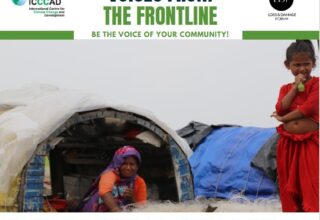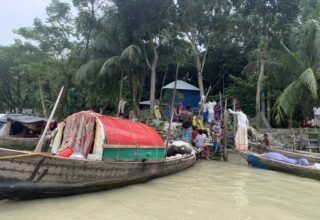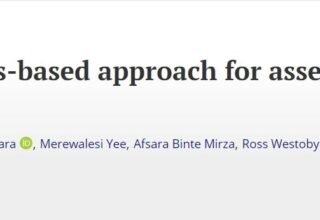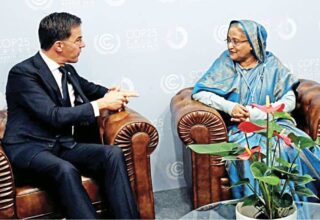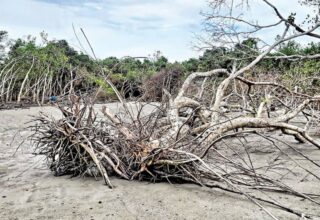The Paris Agreement (PA) on climate change which was achieved at the 21st conference of Parties (COP21) of the United Nations Framework Convention on Climate Change (UNFCCC) in Paris in December 2015 was historic in several ways.
Firstly, it, unlike its predecessor the Kyoto Protocol, which only required developed countries to take actions to reduce their emissions of greenhouse gases, includes all countries, both developed and developing, who have pledged to take actions at home to reduce their emissions as much as possible.
Thus it is a truly universal agreement regarding taking actions to reduce emissions from use of fossil fuels.
Secondly, it includes a long term global temperature goal of staying below 2 Degrees Centigrade above pre-industrial levels while striving to stay below 1.5 Degrees. This was due to active advocacy and diplomacy from the most vulnerable countries, including Bangladesh, to persuade others to include the 1.5 Degree goal in addition to the previously agreed goal of 2 Degrees.
Thirdly, the PA put in place the mechanism through the newly created Green Climate Fund (GCF) for delivering the pledges from developed countries, of funding support of 100 Billion US Dollars each year starting from 2020 onwards, with an expectation that the amounts would increase in time to help the developed countries tackle climate change through both mitigation as well as adaptation. The Board of the GCF in turn have decided that they would allocate half their funds to mitigation and half to Adaptation, with the latter being focused on the most vulnerable developing countries.
Fourthly, the PA put in place a new global goal on adaptation which mirrors the long term temperature goal which was not well defined as adaptation is very site specific and difficult to aggregate across countries. This goal will need to be developed over time.
Fifthly, the PA in its article 8 on Loss and Damage finally recognised that loss and damage was a new and important topic that needed to be addressed in addition to the already accepted issues of mitigation and adaptation. This was also a big win for the vulnerable developing countries, including Bangladesh as we had been arguing for this for a number of years.
I will address below how each of the above issues agreed in the PA can be implemented in practice both globally as well as in Bangladesh.
Firstly, and perhaps most importantly, being a universal agreement it is important that each and every country takes their obligations seriously to take actions to tackle climate change through both mitigation as well as adaptation. For Bangladesh this means that the commitment to mitigation is as serious as the commitment made at COP 23 in Marrakech in November 2016 as part of the Climate Vulnerable Forum (CFV) to become 100 percent renewable energy by 2050. It also means that we need to continue to be very active on the global diplomatic front both through the Least Developed Countries (LDC) as well as the CVF to push all countries to raise their levels of ambition as well.
Secondly, in the long term, global temperature goals. The world has already crossed 1 Degree above the pre-industrial revolution and thus staying below 2 Degrees will be very difficult and many are saying that 1.5 Degrees may already be beyond reach. The actual situation is that it is still possible to stay below 1.5 Degrees but this will require all, including developing countries such as China, India and even Bangladesh, to raise their ambitions to reduce emissions to a much higher level.
The effort to raise ambitions are therefore the most important priority for Bangladesh both at home as well as in its diplomacy and global advocacy.
Thirdly, on global funding for developing countries to tackle climate change these promises and pledges made by the developed countries need to be kept and the procedures for access to that funding also need to be made easier than they have been in the past. This will require considerably enhanced improvement in reporting and transparency of global climate funds, both from those countries providing the funds as well from those receiving the funds.
Here Bangladesh has an opportunity to access the global funds by developing its own capacity to do so and by ensuring that the funds are used in a transparent manner and monitor the results to ensure that they actually benefit the most vulnerable communities.
Fourthly, on the new global adaptation goal which needs to be developed, Bangladesh has an opportunity to play a leading role in developing the indicators and methodologies for assessing successful adaptation. Having invested in hundreds of adaptation actions from the community level to the sectoral and national levels over the last decade, Bangladesh has gained a significant amount of experience of what works and what doesn’t. As gaining knowledge on adaptation comes from learning-by-doing, we are in a good position to capture the learning from our own experiences so far.
Thus Bangladesh has an opportunity to be a world leader in developing measurement, verification and reporting (MRV) on adaptation which is an essential pre-requisite for agreeing on the details of the global adaptation goal.
Fifthly, the issue of loss and damage which we fought hard to include in the PA, is an extremely important issue where we need to develop agreed methods to deal with issues of liability and compensation at the global level for which Bangladesh needs to keep up the active diplomatic activities globally.
Also at the domestic level, the country may wish to develop a National Mechanism On Loss and Damage as an example for other counties to follow. Thus Bangladesh has another opportunity to be a world leader on this important issue.
Finally let me address two other issues, namely the effect of the policies of the President Trump and also the desire for Bangladesh to graduate from LDC status within a few more years.
On the effect of President Trump’s policies on climate change, once they become known, we can expect backtracking on both actions to reduce emissions domestically in the US as well as providing funds for developing countries. While both these actions, if indeed taken in reality, will be a major setback for achieving the goals of the PA they will not cause other countries to backtrack so will probably have relatively little effect on global actions.
On Bangladesh’s vision to graduate from LDC status and strive to become a middle income country over the next few years, while a laudable aspiration it will need the government, along with other stakeholders such as the private sector, civil society and academic sectors to work together and build both awareness as well as capacities to tackle climate change, both through adaptation (which should remain our priority) as well as mitigation.
When it comes to taking actions to tackle climate change Bangladesh has an opportunity to change its global image from being one of the most vulnerable countries to the adverse impacts of climate change to being one of the world leaders in tackling the problem.
Originally this article was published on February 27, 2017 at Daily Star, The author Dr. Saleemul Huq is the director of the International Centre for Climate Change and Development (ICCCAD) at the Independent University, Bangladesh (IUB).
Email: saleemul.huq@iied.org

